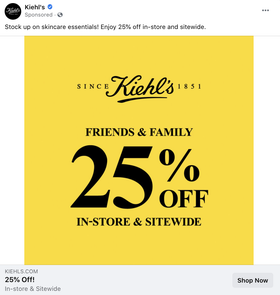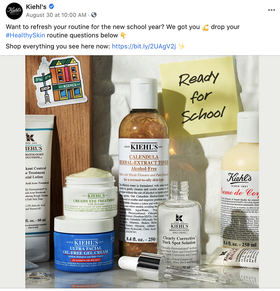How to Build Brand Recall in a Clickless World
Brand awareness is dwindling in organic search. Here's your strategy for building brand equity and recall by leveraging brand awareness. Learn more here.
Read More
Social media marketing has evolved quite a bit over the past few years. Strategies used to be about engagement and creating a more genuine and personal presence online. Now, social media is used for the full customer journey, including customer acquisition, remarketing, retention, and service. Let’s explore paid social vs. organic social media and why it’s important to have a hybrid strategy in place.
This comparison is much like organic search vs. paid search. Organic social is any social media activity without a paid promotion. It uses free social media tools to build and engage with an online following. Paid social, a.k.a. social media advertising, refers to anything on social media that’s influenced by advertising dollars. In other words, advertisements or sponsored posts that brands pay a social network to display to audiences beyond their followers. Cost-per-click (CPC) is one of the most common methods of charging for this type of promotion. Paid and organic social strategies work best in tandem to simultaneously engage with and nurture your followers while extending the reach of your brand to a broader audience.

Paid ads will typically include a “sponsored” badge and a CTA.
As organic reach continues to plummet, social ads enable brands to break through algorithms and connect with audiences that are unlikely to discover them otherwise.
If you’ve developed a content offering that’s converting like crazy, use paid social to spread the offer to your ideal audience and get an instant boost in conversions.
64% of people surveyed say they use social media to find shopping inspiration, meaning that the majority of your audience could be receptive to your promotional messages.
Use paid campaigns to reinforce the values and messaging that you release through organic social.
Leverage audience targeting to tap into the precise shoppers that you want to reach. For example, Publix (a liquor store) uses geographic targeting to reach 21+ consumers who are near their store locations in the Southeastern US.
Pro tip: Thanks to our robust audience targeting, AI-powered retargeting, and comprehensive ad formats, our social media advertising platform is the best way to get started with paid social ads (or level up your existing ones!).

From static ads to carousels to videos ads, AdRoll has you covered.

Organic social posts — which are only shown to a brand’s followers — are a great way to engage directly with customers.
Organic social is free.
Use organic social to manage your reputation and customer relationships. Reply to consumers directly when they have issues to boost confidence in your brand.
Listen to your audience and embrace the opportunity to acknowledge their observations and make improvements.
Develop free campaigns using custom hashtags.
Build a community of like-minded individuals who share your company values.
Establish trust and demonstrate transparency.
Embrace social channels as an opportunity to tell your brand story.
Encourage user-generated content (UGC) that relieves your marketing team of content creation duties and demonstrates social proof that is valuable to consumers.
Complete marketing approaches to social media are less about paid social vs. organic social. Instead, they combine the power of these two strategies. As organic reach continues to diminish across social platforms, it’s increasingly important to invest in paid social opportunities to reach a broader audience. Making an impact solely through organic reach, unfortunately, is more of a dream than a reality at this point in the social media evolution. On Facebook, organic posts only reach about 2% of followers, and that number is steadily declining.
However, to avoid spending every last dollar on paid social, organic social is necessary for ongoing success. Although organic reach is in decline, the benefits of organic social are still tremendous. It provides an incredible opportunity to promote your company and products for free to a loyal audience and extends your network through social sharing. As long as marketers focus on adding value rather than bombarding audiences with sales pitches in every post, fans will stick around to see what’s next.
Make your marketing dollars go even further by using organic social and other marketing efforts to determine which content is most popular with your audience before running it as a promotion. Instead of wasting time experimenting with your paid social campaigns, experiment with organic social, email campaigns, and other no- or low-cost methods, and use the winners for paid social ads and promotions. For both paid and organic social posts, make sure that you keep track of analytics to determine the most effective days and times to post.
The companies Casper and Dollar Shave Club are excellent examples of digital-native brands that give established companies a run for their money. These brands are savvy when it comes to using social media to their advantage and understanding how to effectively target their audiences while managing acquisition costs.

A catchy video + social proof + FOMO + an offer = an A+ ad from Dollar Shave Club.
Headspace, an app for meditation, uses a combination of paid and organic social media to spread its message. The company’s organic social strategy is centered around building a community through helpful tips and inspiration that its audience values. The company’s paid social campaigns echo this style of post and further solidify the brand’s personality with engaging graphics that speak to customer pain points. The drawings show a quick visual comparison of how individuals feel now and how they’ll feel after using Headspace.
The power of these companies lies in their ability to build a community online. They’re modern in their approach to communicating with customers, placing value on transparency, clarity of purpose, and continual experimentation that makes for a unique social media experience. Sophisticated knowledge of their audience and a deep understanding of social media enables them to achieve relatively low PPC costs on the paid social side, while also continuing to nurture audiences using an organic social approach.
Using cross-channel data attribution and real interactions to gain a unique understanding of their audiences
Using an audience targeting tool for precision-targeting their audiences
Developing niche, loyal followings that enjoy their organic social experience
Leveraging new shopping features on social media to make purchasing easy and cut the buying cycle
Being incredible storytellers and captivating audiences
Establishing trust with their followers
Making social media a fun and shareable experience
Prioritizing customer acquisition costs (CAC) as a critical growth factor and using this number as a benchmark for ad spend
Embracing strategies that effectively lower CPC costs and boost ROI by drawing good insights with a digital marketing dashboard
Understanding the difference between vanity metrics and essential KPIs
Remaining flexible and experimental in their approaches to social marketing
Using the modern consumer’s desire for transparency, personalization, quality, and trust to explore new ways of delivering products to the market. This approach gives them an advantage when it comes to quality, pricing, and unique delivery options.
Modern consumers are making it easier than ever for smaller brands to compete against large, established corporations. Shoppers’ desires for transparency, direct contact with companies, authenticity, brands with shared values, and a personal connection can often be better-satisfied by smaller companies than legacy brands.
Social media is the ideal channel for communicating with these audiences and giving them a place where they can feel like they are part of a community. A sense of belonging, enthusiasm, and loyalty can be established through a thorough organic social strategy and reinforced through paid social campaigns. Ultimately, paid social vs. organic social is an unrealistic choice to make. The modern marketing approach that genuinely pays off combines these two approaches in a way that makes each one stronger than if they were run independently.
Pro tip: Social media plays a pivotal role in building brand awareness, but it's not the only thing. This interactive brand building workbook on how to build a thriving digital brand will help accelerate your business growth.
Last updated on May 15th, 2023.